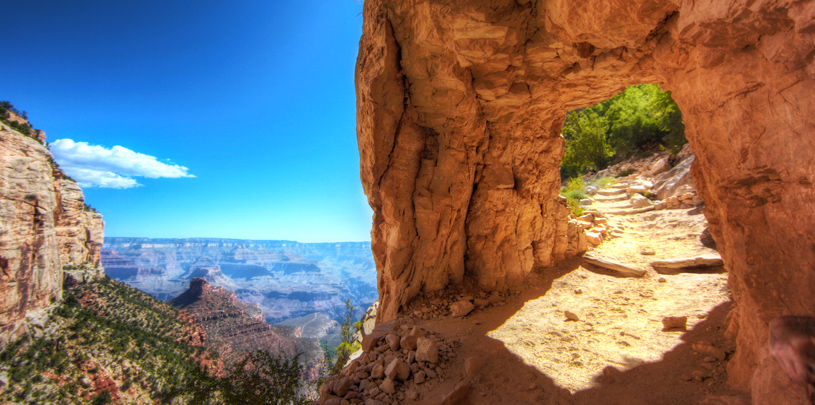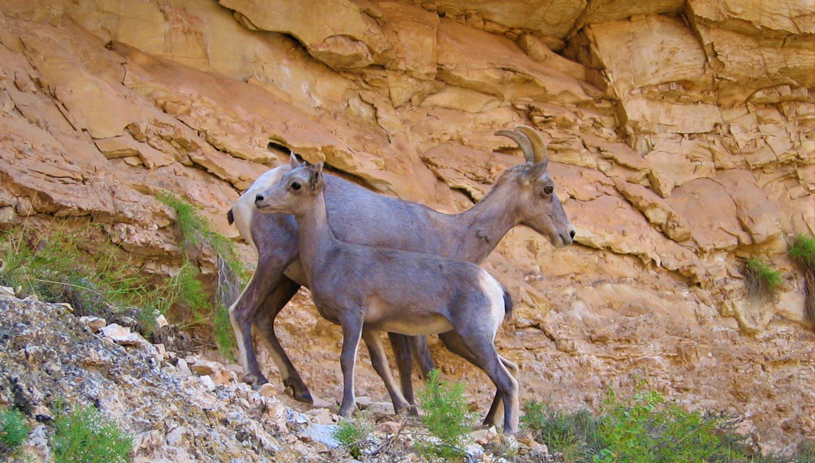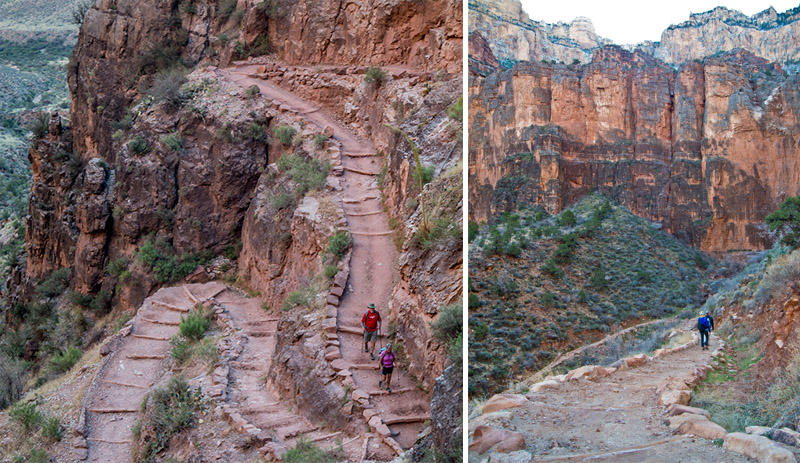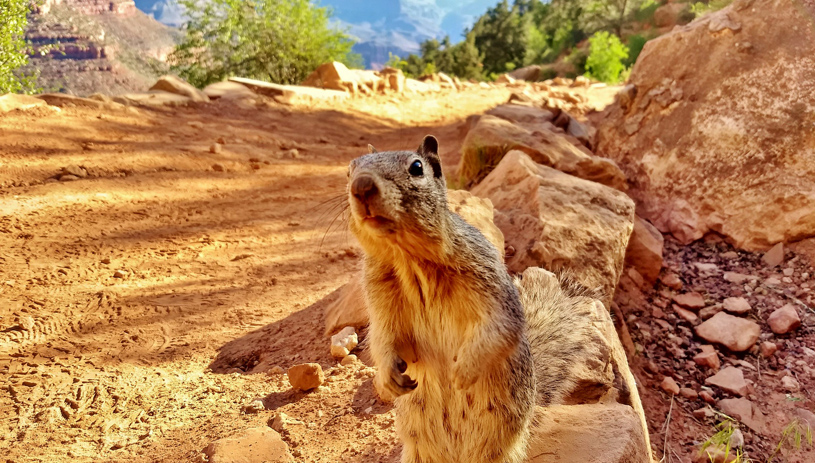
 by Ellen Heyn, Digital Media Director
by Ellen Heyn, Digital Media Director
Although millions of people visit Grand Canyon National Park each year, few ever set foot below the canyon's rim. But you don't have to hike all the way down to the Colorado River to experience the Grand Canyon for yourself.
 A bighorn sheep and her lamb on the upper Bright Angel Trail in Grand Canyon National Park. NATIONAL PARK SERVICE
A bighorn sheep and her lamb on the upper Bright Angel Trail in Grand Canyon National Park. NATIONAL PARK SERVICE
Bright Angel Trail is one of the most popular and well-traveled trails into the canyon and has been used by Native people for millennia.
Hikers often train for months before braving this route into the mile-deep canyon. There's heat, altitude, rapid changes in elevation, and abrupt changes in weather to consider. But if you have the right footwear and supplies, even a short walk into the canyon — a journey of a few hundred steps — offers a deeper perspective.
Just remember, at the Grand Canyon, every step you go down, you have to come back up.
 Fresh snow on the Bright Angel Trail in Grand Canyon National Park. MICHAEL QUINN, NATIONAL PARK SERVICE
Fresh snow on the Bright Angel Trail in Grand Canyon National Park. MICHAEL QUINN, NATIONAL PARK SERVICE
Strolling along the paved Rim Trail among flocks of tourists, you'll find the Bright Angel Trailhead just west of Kolb Studio, a dark-brown building clinging to the cliffs at the top of the south rim.
From about May to October, expect hot hiking temperatures. In the winter months, you may find the trail coated in freshly fallen snow, or sheathed in stubborn ice, making microspikes a necessity.
If you hike the whole thing, Bright Angel Trail descends 9.5 miles, from an altitude of 7,000 feet at the canyon's south rim to 4,460 feet at the Colorado River. But venture just a few hundred steps down the trail and you'll find yourself looking up at towering cliffs of Kaibab Limestone — the youngest rocks in the Grand Canyon — and get your first taste of what it feels like to actually be inside the canyon.
From the bottom of the trail, you can connect with the steep South Kaibab Trail to return to the South Rim or the North Kaibab Trail, which leads all the way to the north rim of the Grand Canyon, for rim-to-rim hikers.
 Bright Angel Trail, Grand Canyon National Park. ELLEN HEYN
Bright Angel Trail, Grand Canyon National Park. ELLEN HEYN
Grueling 24-mile rim-to-rim hikes connecting Bright Angel Trail (or South Kaibab Trail) to the North Kaibab Trail have become popular with bucket-listers. But Bright Angel Trail offers good turnaround spots for shorter hikes too. Some shorter day hike options along the Bright Angel Trail include:
First tunnel
It takes the average hiker about 20 minutes to hike the 0.1 miles roundtrip to the first tunnel.
Second tunnel
It takes the average hiker 1-2 hours to hike the 1.8 miles roundtrip to the second tunnel, with 590 feet in elevation change.
1½-Mile Resthouse
It takes the average hiker 2-4 hours to hike the 3 miles roundtrip to the first resthouse, with 1,120 feet in elevation change. The resthouse offers pit toilets, a small shade structure, and seasonal water (from mid-May through mid-October).
3-Mile Resthouse
It takes the average hiker 4-6 hours to hike the 6 miles roundtrip to the second resthouse, with 2,120 feet in elevation change. The resthouse offers pit toilets, a small shade structure, seasonal water (from mid-May through mid-October), and spectacular views.
Havasupai Gardens
It takes the average hiker 6-9 hours to hike the 9 miles roundtrip to Havasupai Gardens, with 3,040 feet in elevation change. The gardens offer shade, pit toilets, and seasonal water (from mid-May through mid-October). The National Park Service recommends checking in with a park ranger before attempting this as a day hike.
For millenia, Havasupai people lived and farmed here before being forcibly removed by the National Park Service. The park service officially renamed the site (formerly Indian Garden) in 2022 to honor the Havasupai Tribe and Havasupai history.
Plateau Point*
It takes the average hiker 9-12 hours to hike the 12 miles roundtrip to Plateau Point, with 3,080 feet in elevation change. There are no toilets or water at Plateau Point, although it does offer views of the Colorado River and the inner gorge. The National Park Service recommends checking in with a park ranger before attempting this as a day hike.
Pro tip: Pack more water, electrolyte drinks, and salty snacks than you expect to need. All the water along the trail (and all the water on the South Rim) comes from Roaring Springs, on the North Rim, and the aging pipeline that transports it often breaks. It's not uncommon for the water spigots to be turned off at Havasupai Gardens and the resthouses. Plus, if you bring more than you need, you'll have spare to share with hikers in need.
Descending the Bright Angel Trail is like walking back through geologic time, from the youngest rocks, to the oldest. The dark basement rocks of the canyon are almost 2 billion years old.

Grand Canyon National Park encompasses the traditional lands of at least 11 tribes — the Havasupai Tribe, Hopi Tribe, Hualapai Tribe, Kaibab Band of Paiute Indians, Las Vegas Band of Paiute Indians, Moapa Band of Paiute Indians, Navajo Nation, Paiute Indian Tribe of Utah, San Juan Southern Paiute Tribe, Pueblo of Zuni, and Yavapai-Apache Nation. Like many of our national parks, the Grand Canyon's story is one of forced displacement of Native peoples who still call it home and continue to live, work, and maintain strong cultural connections here to this day.
Thousands of years of Native history is visible in petroglyphs, granaries, and other cultural sites throughout the canyon.

Many animals call the canyon home. If you're lucky, you might spot bighorn sheep picking their way along the rocks or California condors soaring overhead. Squirrels can be brazen pickpockets, so if you stop for a snack, keep a close eye on your food and never feed the wildlife. Nine species of rattlesnake live around the Grand Canyon, so stay on the trail and watch where you put your feet and hands.
Remember, if you're planning to sleep overnight in the Grand Canyon, you need a backcountry permit. Don't panic! Getting one is doable.
Pro tip: If the developed campsites at Havasapai Gardens Campground and Bright Angel Campground are full, consider getting a permit to disperse-camp along the Clear Creek Trail, a few miles up from Phantom Ranch, on the north side of the river. Although you'll have to pack in your water, this less-traveled trail offers expansive views of the Colorado River and spectacular night skies.
The National Park Service maintains these trails and campgrounds, so be sure to check in with the park about any upcoming closures, including a few scheduled for 2024 and 2025. Happy trails!
The Colorado River below Glen Canyon Dam is heating up. Find out why.
Read MoreGroundwater pumping at a uranium mine near the Grand Canyon will affect the canyon's springs, scientists says.
Read MoreArizona Governor Katie Hobbs is the latest elected official to call for an environmental review of Pinyon Plain uranium mine.
Read More